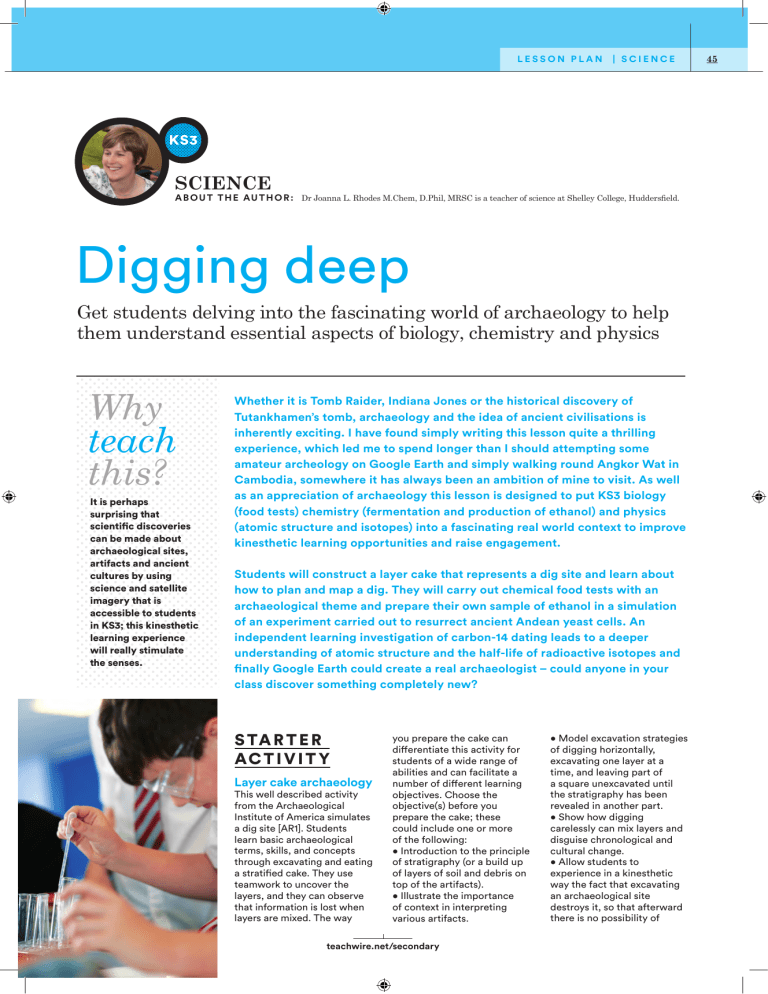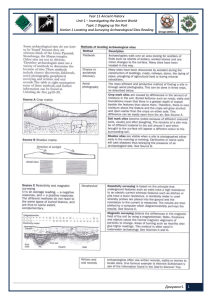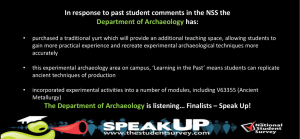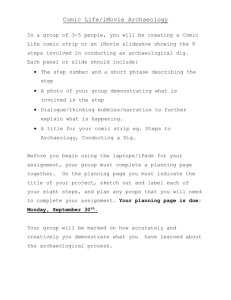
LESSON PLAN | SCIENCE KS3 SCIENCE A B O U T T H E AU T H O R : Dr Joanna L. Rhodes M.Chem, D.Phil, MRSC is a teacher of science at Shelley College, Huddersfield. Digging deep Get students delving into the fascinating world of archaeology to help them understand essential aspects of biology, chemistry and physics Why teach this? It is perhaps surprising that scientific discoveries can be made about archaeological sites, artifacts and ancient cultures by using science and satellite imagery that is accessible to students in KS3; this kinesthetic learning experience will really stimulate the senses. Whether it is Tomb Raider, Indiana Jones or the historical discovery of Tutankhamen’s tomb, archaeology and the idea of ancient civilisations is inherently exciting. I have found simply writing this lesson quite a thrilling experience, which led me to spend longer than I should attempting some amateur archeology on Google Earth and simply walking round Angkor Wat in Cambodia, somewhere it has always been an ambition of mine to visit. As well as an appreciation of archaeology this lesson is designed to put KS3 biology (food tests) chemistry (fermentation and production of ethanol) and physics (atomic structure and isotopes) into a fascinating real world context to improve kinesthetic learning opportunities and raise engagement. Students will construct a layer cake that represents a dig site and learn about how to plan and map a dig. They will carry out chemical food tests with an archaeological theme and prepare their own sample of ethanol in a simulation of an experiment carried out to resurrect ancient Andean yeast cells. An independent learning investigation of carbon-14 dating leads to a deeper understanding of atomic structure and the half-life of radioactive isotopes and finally Google Earth could create a real archaeologist – could anyone in your class discover something completely new? S TA R T E R AC T I V I T Y Layer cake archaeology This well described activity from the Archaeological Institute of America simulates a dig site [AR1]. Students learn basic archaeological terms, skills, and concepts through excavating and eating a stratified cake. They use teamwork to uncover the layers, and they can observe that information is lost when layers are mixed. The way you prepare the cake can differentiate this activity for students of a wide range of abilities and can facilitate a number of different learning objectives. Choose the objective(s) before you prepare the cake; these could include one or more of the following: • Introduction to the principle of stratigraphy (or a build up of layers of soil and debris on top of the artifacts). • Illustrate the importance of context in interpreting various artifacts. teachwire.net/secondary • Model excavation strategies of digging horizontally, excavating one layer at a time, and leaving part of a square unexcavated until the stratigraphy has been revealed in another part. • Show how digging carelessly can mix layers and disguise chronological and cultural change. • Allow students to experience in a kinesthetic way the fact that excavating an archaeological site destroys it, so that afterward there is no possibility of 45 46 LESSON PLAN | SCIENCE checking information not recorded. • Show the importance of carefully recording the finds in each layer. The dig could contain a range of different types of artifacts including sections of wall, pots, knives and human remains(burial site or graves). This is simulated very well using Lego pieces but be sure to introduce them between the layers of the cake after it has been cooked! MAIN AC T I V I T I E S 1. Chemical archaeology Chemistry is now used extensively on archaeological digs to study many aspects of ancient life. One of the most fascinating is the study of pottery vessels and food containers as chemical residues from food have been found to survive in the porous pottery surface for several thousand years. The school of Chemistry at Bristol University provides an interesting introduction to this branch of chemistry [AR2]. In this activity students investigate the diet of ‘ancient’ people using chemical food tests. To prepare for the activity break some pottery medium sized fragments (about 5-10cm2). The best HOME LEARNING Carbon dating is a tool used to date objects that contain organic material that was once alive. It measures the ratio between carbon-12 and carbon-14 a radioactive isotope that is only renewed in animals and plant while they are alive and exchanging carbon with the environment. Once the animal or plant has died, the amount of carbon-14 gradually decreases by radioactive decay, a process with a known half-life. The amount that is left, tells us the approximate age of the artifact. Ask students to draw a diagram of the subatomic particles in the three isotopes, 12C, 13C and 14C, and to explain the similarities and differences between their atoms. Secondly ask students to estimate the age of a range of artifacts such as carved wooden objects or mummified remains of humans or animals based on the percentage of 14C left in them using the graph provided on BBC Bitesize [AR8]. As an extension question, ask them if they can use the graph to work out the half-life of carbon-14. type of pottery to use is various plant pots. We found a local garden centre was be willing to donate some of their breakages which also gave us a realistic range of colours and glazes for our dig. Soak the plant pots in four food-based solutions or paint on the solutions and then leave to dry overnight in air or a warm oven. Food type 1 – glucose solution Food type 2 – protein solution (egg whites) Food type 3 – starch solution Food type 4 – vitamin C (orange juice or ascorbic acid solution) In the lesson students become chemical archaeologists and test the ‘food’ residues on each of the pots. Each piece of pottery should be photographed, numbered and bagged before and after the tests to ensure results are recorded against the correct fragment. Once the pieces have been numbered and bagged, each piece of pottery should be individually washed into a separate beaker using a small amount (25cm3) of solution of water. All the washings should be retained and labeled with the number of the corresponding piece of pottery. The solution should then be carefully tested in 2cm3 portions, which should allow for the experiment to be repeated twice for each piece of pottery. The chemical tests are as follows [AR3]: • Benedict’s test for reducing sugars (glucose). Add 2cm3 of the sample solution to a test tube. Add an equal volume of teachwire.net/secondary Benedict’s solution to the test tube and swirl the mixture. Leave the test tube in a boiling water bath for about 5 minutes observing any colour change. If sugar is present it will change from blue to green and possibly even to yellow or red. • Biuret test for protein. Add 2cm3 of the sample to a test tube and add 2cm3 of Biuret Reagent. Shake well and allow the mixture to stand for 5 minutes. Look for colour changes in the solution. If proteins are present it will range from no colour change (blue) to pink to deep violet. • Iodine test for starch. Add 2cm3 of the sample to a test tube and add 5-10 drops of iodine solution. If starch is present the solution will turn blue/black. • DCPIP (2,6 dichlorophenolindophenol) 47 EXTENSION FOR GIF TED A N D TA L E N T E D P U P I L S With the availability of satellite images and Streetview images from Google Earth along with accurate measuring tools, it is no longer necessary to visit an archaeological site in order to draw a map or plan or even to take a look around. Provide a piece of graph paper and ask students to create a plan of an ancient site such as Pompeii, the Nazca lines, Macchu Picchu, Stonehenge, and one of the most impressive I have seen is Angkor Wat in Cambodia. Not only is the level of detail available on Google Earth incredible but you can also visit inaccessible minor temples in the jungles many of which also have streetview and 360° images. New archeological features have been discovered using Google Earth. Students who think they may have discovered their own might be interested in the ArchAtlas Project [AR9] which is collating images and essays on some of the discoveries made by Google Earth users. test for vitamin C [4]. Add 2cm3 of DCPIP solution to a test tube. Add the food solution one drop at a time, to a test tube containing a light blue solution of DCPIP. If the extract is acid the colour will change from blue to red. Continue to add more and see if the colour disappears altogether. Decolourisation of DCPIP shows that a vitamin C is present. You could consider whether to give students the artifacts in a shoebox simulated dig [AR5] as described by the Archaeological Institute of America, to add a greater degree of realism. Also be clear on the method of feedback. Students could present their work as a report, or deliver a PowerPoint to a sponsor or give a talk in the style of a museum lecture. 2. Explore ancient alcoholic drinks Share with students an article from Scientific American [AR6], which describes how yeasts from fermentation vessels in an Andean tomb were scraped from the pottery and repaired using microbiology. The resurrected microbes were characteristic of those found in saliva and even faeces, proving how these ancient people used these bodily wastes to start the fermentation of their alcoholic beverage known as chicha. In this activity provide students with sample of ‘ancient’ yeast (use ordinary brewers yeast), which they can use to ferment a sugar solution. This can be done using a method described by the Nuffield Foundation [AR7]. It would be advisable to set the fermentation process going at the end of a lesson as it will take a few days for sufficient alcohol to form. Next lesson, students can smell the fermented solution, which will now smell distinctly alcoholic. The Nuffield method also describes how to isolate and purify the ethanol using distillation. This is an excellent opportunity to set up laboratory glassware that students may not have seen or used before and to inspire an interest in chemistry and in particular, organic synthesis. Once isolated the alcohol could be tested using acidified potassium dichromate. In this test 2cm3 of the alcohol is ADDITIONAL RESOURCES [1] Layer cake archaeology ow.ly/M4uD308ImUU [2] Archeological chemistry ow.ly/9C5t308ImXx [3] Chemical food tests ow.ly/WSzH308ImZD [4] DCPIP test for vitamin C ow.ly/23lq308In1E [5] Shoebox dig ow.ly/wwKn308In4I [6] Andean yeast resurrection ow.ly/97WW308In7R [7] Fermentation of sugar solution using yeast ow.ly/wtFl308Inat [8] Carbon dating ow.ly/vMNp308IndG [9] ArchAtlas ow.ly/ZtKU308Ing0 teachwire.net/secondary placed in a boiling tube in a water bath at about 60°C. 1cm3 of potassium dichromate made up using 1 mol dm-3 sulfuric acid is added. The colour change from bright orange to green/ blue confirms the presence of ethanol.






